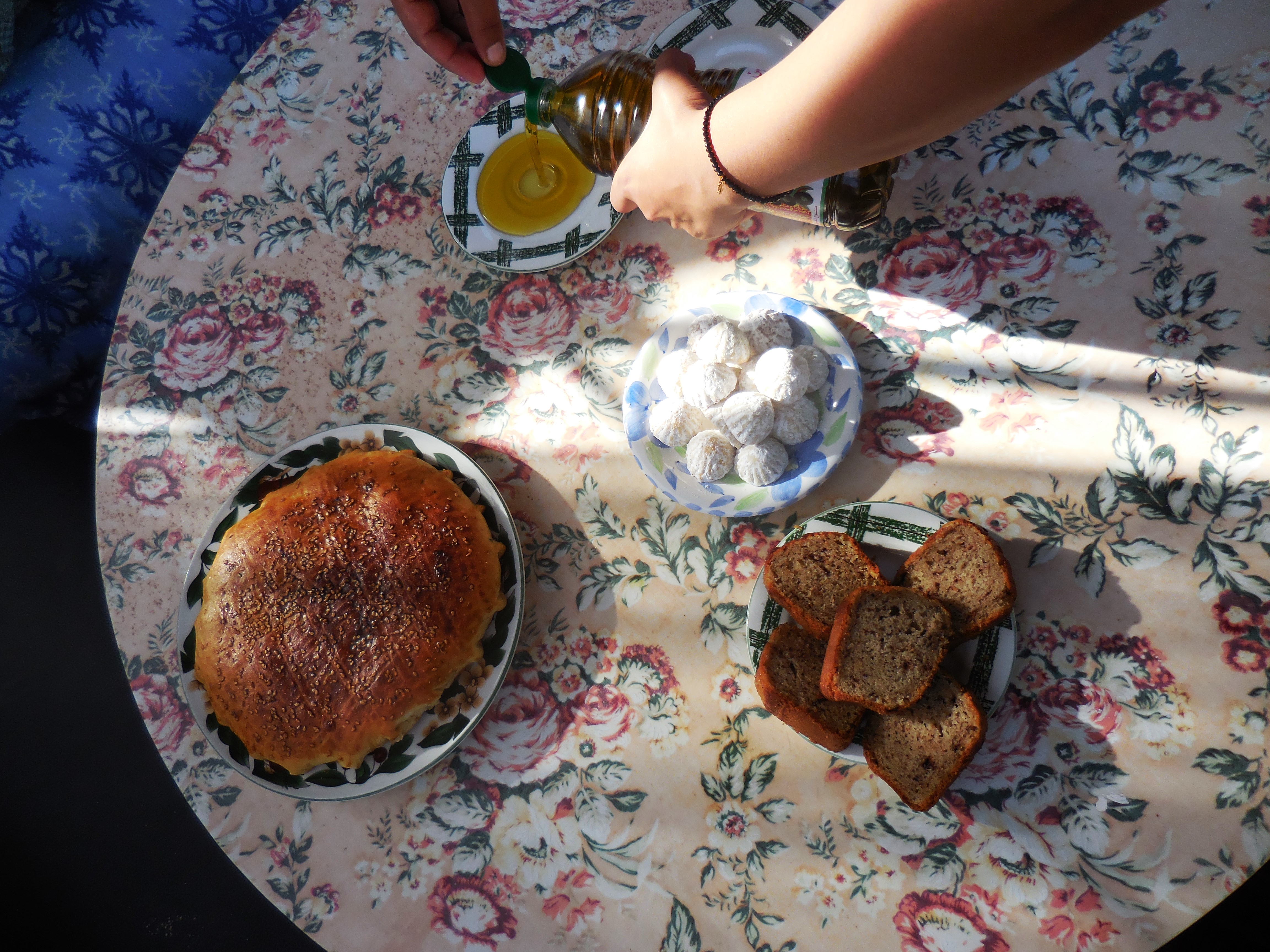I lied (but only partly) in my last post. As I just downed a bread and a half with olive oil, I realized I would be remiss to not talk about Moroccan food, aka the only thing good enough to (almost) cure my germophobia.
First, the food. There’s bread! Bread! And bread! I’m sure there are as many kinds of Moroccan bread as Peruvian potatoes, but the ones to which I’ve heretofore been exposed are:
Khubz: Basic bread, round, soft, that you can eat with literally everything and is incredible with olive oil. FRESH OLIVE OIL!
Melwee: Also goes by a few other names that I can only write without vowels (ah, Arabic); my host mom describes it as a Moroccan crepe. But it blows French crepes out of the water. This is my favourite—it’s flat and tastes like a combination of naan and sunshine. You have to eat it from the street to believe it.
Baghreer: A savoury pancake with holes. Eaten with butter and honey.
Corn kine bread: I forget the name, but my host mom told me the recipe! It’s made out of some kine corn flour, salt, dat ting dat make bread rise, and water. Tanks bruh*
Of course there are also baguettes and croissants (does the latter count as bread?) and some sort of bread that’s made out of pasta-looking strings and is only sold by silent old women in the middle of the street. Lots and lots of bread.
There are also loads of delicious fruits and vegetables: apples, tomatoes, eggplant, squash, oranges, cucumbers, etc. My three favourite foods in the world are bread, tomatoes, and cheese (and I have medium-high standards for all three), and so here, I’m in heaven. Two out of three on a regular basis is great! And we have pizza places and an open-air mini-fromagerie right around the corner; the former is good (and $1.50 for a personal pizza!) and the latter is something I’ll probably never be brave or foolish enough to try. And there are lots and lots of chocolate in different varieties and pastries for very cheap. Anyone who studies abroad in France for the food (and/or language, honestly) should consider coming here instead.
But that’s only the beginning. There’s also the food my host mom makes, which is beautiful and delicious. This is how delicious:
At home, I won’t share food with anyone; last year at some party, a friend took a piece of my apple pie with his hand and I nearly cried (thanks JA). I have cried when family members have taken bites of my ice cream. It’s probably best that I didn’t know before going to Morocco that everyone eats out of the same plate. They didn’t even tell us this in orientation here—we were told, oh, you scoop things up with bread so your germs don’t touch those of other people (it wasn’t phrased quite like that, but that’s how I heard it). Nope. At my host family’s, we use spoons. Giant spoons. And one giant dish.
Already being the weird foreigner who doesn’t eat red meat or fish, I didn’t want to impose any more on hospitality by asking for a plate of my own. But I’d been pretty much fine; everyone, when eating, sticks to their little zone on the plate (think pizza slice lines), and I figured out that if I was one of the first to finish I would be fine (since no one else cares about catching germs).
Today, though, we had leftovers for the first time of my host mom’s dish, deceptively simple chicken and noodles and spices. Leftovers from that giant plate that had been touched by everyone’s spoon. And I ate them, despite the fact that there was also khubz and cake. That’s how good it was. The chicken noodles were better than fresh bread and fresh olive oil; more powerful than my brain screaming “NO! GERMS!”. Honestly, in retrospect I feel a bit odd, and I don’t think I’ll ever truly adjust to this part of the culture, but that’s how awesome the food is.
Digression over. Much of the food we eat at home is some sort of tagine, which is meat and some vegetables. The meal is named after the pot in which it’s cooked, which is shaped like one of those old Chinese hats. Tagine (the food) can consist of any sort of meat (or fish) and vegetables; and the spices make the meal. My favourite so far has had chicken, chickpeas (hummus in darija), tomatoes, and a few mystery vegetables. Also, we sometimes eat pasta. Last night, because my vegetarian friend was staying over, we had a rice and milk/yogurt dish. My American friend loved it so much she ate about half the plate (no rice leftovers!). There was also a crepe, lentil, and chicken plate (usually for festive occasions, still not quite sure what the occasion was) that haunts my dreams. And every Friday, every Moroccan family has couscous!
Even the food at the university cafeteria is amazing! But nothing beats my host mom’s cooking.
There are an incredible amount of superlatives in this article, but it really is that good. One last thing is mint tea. We drink it with nearly every meal (the school cafeteria workers assume we need a break). Travel tip #2: for the love of your enamel, don’t get it at a café, or at least make an unwitting friend taste it before you— the mint tea I’ve had in cafes manages to rival sweet tea* in terms of “is this tea or triple-concentrated flat soda?”. But at home it tastes like mint! And yes, it’s still pretty sweet, but also bitter, so it works. And the mint is all green and fresh; you can smell it while walking around the market and it makes you smile. And my host dad pours the tea so it gets all aerated and it’s good with bread (as is everything).
A demain.
* I can actually get the point across better in Hawaiian pidgin than some mangled French-Queen’s English translation. And before anyone gets offended, this is the dialect of half my family.
*The bane of my Chinese AND Scotch-Irish existence—you don’t do that to tea. You either a. drink it black, or b. make it with milk AND sugar, which you add AFTER boiling the water. Sorry. Sweet tea is one of my nemeses. It sits there looking like innocent Chinese restaurant tea until it hits your tastebuds like a cackling jinni.

